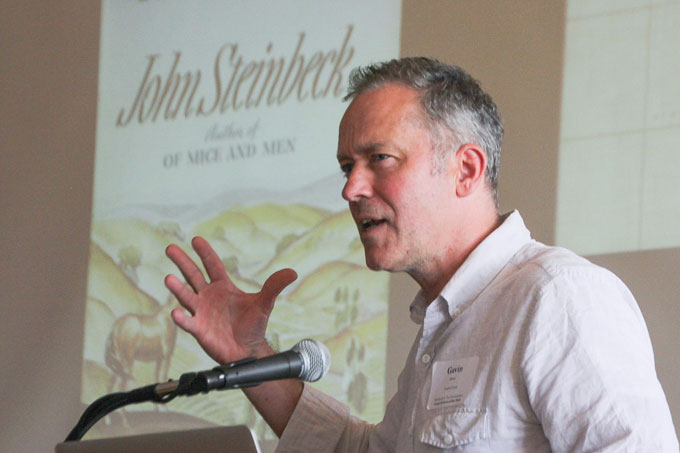If Gavin Jones had been a professor there 100 years ago, would John Steinbeck have stayed at Stanford University long enough to finish? Probably not, according to Jones, who addressed the fraught subject of Steinbeck@Stanford at the Stanford University Library on January 30. Jones—who holds the Frederick P. Rehmus Family Chair in Humanities in the Department of English—spoke to a capacity crowd of 200 at the evening event, which was sponsored by the Stanford Historical Society and included a pop-up exhibit from the library’s collection of Steinbeck manuscripts and memorabilia. Credited with contributing to the revival of campus interest in Steinbeck, who enrolled intermittently between 1919 and 1925, Jones used examples of Steinbeck’s early writing to show how Stanford’s emphasis on creativity, collaboration, and interdisciplinary learning shaped the character, context, and content of works like To a God Unknown and Cannery Row—manuscripts of which, in Steinbeck’s hard-to-read hand, were on display at the event. Although he left without earning a diploma and refused to accept an honorary degree, “Stanford was always on his mind,” said Jones. Assuming “the mythology of a misfit” early in his career, Steinbeck was a life-long experimenter whose insights into ecology, empathy, and eugenics—all shaped by Stanford—were, Jones added, ahead of their time and set him apart from literary figures like William Faulkner, who dropped out of Old Miss, and Ernest Hemingway, who skipped college to work as a reporter.
- Home
- Books
- Life
- Music & Media
- Places & Events
- Politics & Religion
- April 18, 2025
About John Steinbeck

Most read American writer of the 20th century. Born in California. Died in New York. Romantic. Realist. Rebel. More about John Steinbeck
FacebookTwitterLinkedInGoogle+ PinterestMySpaceStumbleUponYouTubeStay In Touch
Receive email updates and stay in touch with SteinbeckNow.com
Recent Posts
- New Video from San Jose State University on John Steinbeck: A Writer’s Vision
- Celebrate! Western Flyer Returns to Monterey Bay
- Henry Fonda’s Daughter, Jane Fonda, to Receive 2023 John Steinbeck Award
- A Chance Christmas Dinner with John Steinbeck in 1947
- Saved! John Steinbeck’s Retreat in Sag Harbor
- Celebrating Woody Guthrie’s Grapes of Wrath Connection
- John Steinbeck Haunts Malcolm Harris’s Palo Alto
- San Jose State Hosts Steinbeck Conference
- For John Steinbeck, the Rains in Pajaro Hit Home
- Photo Inspires Sumi Ink Portrait by Eugene Gregan
Latest Tweets
-
No tweets found.
- View All SteinbeckNow.com Tweets

